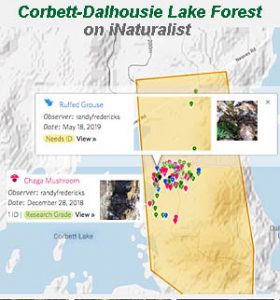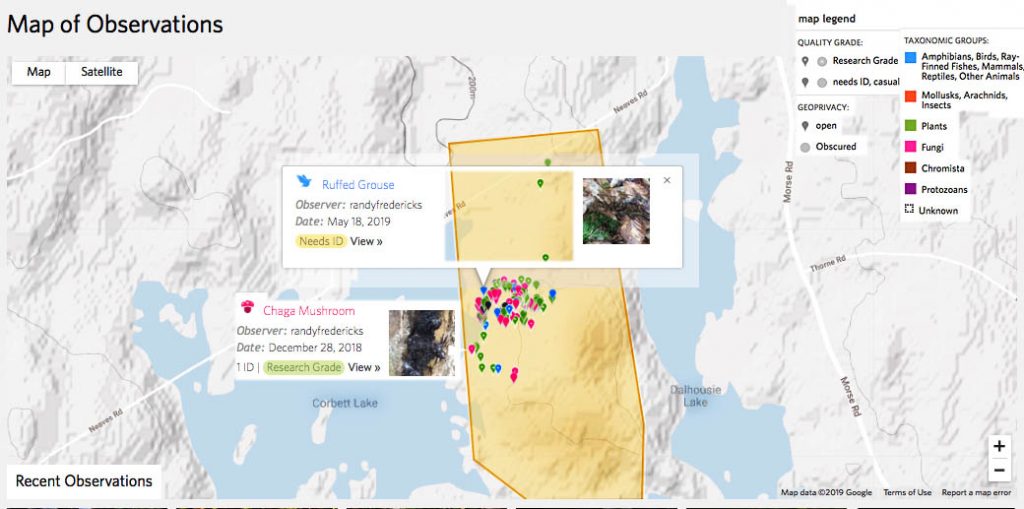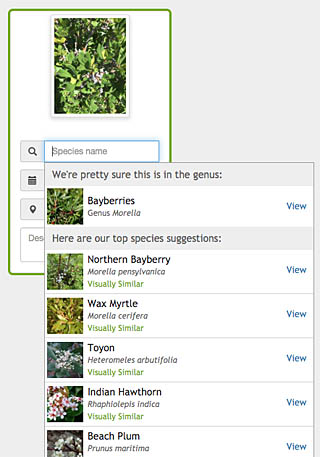Citizen science comes of age in NS forests

Annapolis area naturalist/forest activist Bev Wigney established the first – to my knowledge – iNaturalist Place and Project for a Nova Scotia Crown Land forest subject to logging
It didn’t make national or international news, but Halifax did really well in the recent City Nature Challenge (April 26-29, 2019):
And… the final results are in: Halifax, we did amazing! 7647 observations of Nature representing 911 species in FOUR DAYS!
Mary Kennedy was our top observer (630) and Ben Armstrong observed the most species (163). Together, we were a team of 237 participants (plus all those represented by families or school groups). Overall, Halifax ranked in the Top 50 (of 159 cities) across all categories, and when you weight for climate (latitude) we ranked in the Top 3!
The stats below, which I haven’t seen updated yet, were given on the Halifax Facebook Page one day after the event closed:
– we rank in the Top 40 of all competing cities for total observations and species identified
– among latitudinally challenged cities, we rank #1 in observations per capita
– we soundly beat Calgary and Richmond and are the “most biodiverse Canadian city in the competition”
– We rank #1 for lichen observations per capita among all cities
In this iNaturalist event, anyone in Halifax – or visiting Halifax (all of Halifax Co.) – could contribute – and you didn’t have to be an expert. I happen to know Ben Armstrong – the guy cited above as identifying the most species; he is a computer guy with an interest in natural history but no formal training and is relatively new to species ID. (He learned a lot very quickly using iNaturalist on his many walks.)
How one uses iNaturalist
Here are the basics::
1. Register with iNaturalist; if participating in a time-sensitive project such as the Nature Challenge, you may have to register with the project as well.
2. Take a photo of a living organism or a sign of it (e.g. footprints or scat) and record the location. If the photo is taken with a smart phone, the location is recorded automatically.
3. Upload the photo to iNaturalist. Specify an ID (species name, e.g., Pinus strobus or White Pine); or allow iNaturalist to make a guess (which it does by comparing the image to all images of species on its database for which the ID has ben confirmed). Provide the Lat and Long if those were not attached to the Photo. Make comments as appropriate, and Submit Observation.
That’s it. Then the photo with its preliminary ID sits there until it is confirmed, or not, or is changed by other members of iNaturalist in a self-correcting process.
Also, if you go to the interactive map and zoom in on the area where you made the ID, you can see your specific observation and observations by others in the same area.
iNaturalist as a tool for Conservation Science
iNaturalist works on a self correcting algorthm(s) which over time and with more users becomes ever more accurate, much like Wikipedia. Because of the numbers of people contributing, iNaturalist has become a very significant database for conservation science and now, in addition to “citizen scientists”, many professional conservationists routinely record their observations using iNaturalist.
The first use of iNaturalist to document species on blocks of NS Crown lands subject to logging
Annapolis area naturalist/forest activist Bev Wigney has been an active promoter of iNaturalist and established the first – to my knowledge – iNaturalist Place and Project for a Nova Scotia Crown Land forest subject to logging. It is for the Corbett-Dalhousie Lake Forest*

Screen Capture of Project/Place image for Corbett-Dalhousie Lake Forest, accessed Monday May 20, 2019 a.m. Click on image for larger version.
______
*The Corbett-Dalhousie Lake Forest is the Crown land forest that the Annapolis Royal & Area – Environment & Ecology group began to investigate just before Christmas 2018, as it turned out, due to a mistake by L&F in posting it, and which turned out to contain, if not Old Growth according to DNR/L&F croteria, then many elements of Old Growth. (View NSFN Post May 6, 2019). A “Place” is the geographic Location or boundaries for a Project as shown in the map; a Project can be set up without specifying a Place and a Place with without a Project, or they can be combined.
I picked two observations points from the map above, one of an unconfirmed species (“needs ID, casual”) and the second of a “Research Grade” ID that were by the edges of the set of observations just to illustrate what comes up when you click on them (see insets above).
The currently unconfirmed Observation is of scat (poop), that the Observer (Randy Frederic) thinks is that of Ruffed Grouse. (Obviously, Randy is more than a passing observer of nature; no surprise: he wrote that wonderful letter to the Premier about Hardwood Hill back in November). The second one, of Chaga mushroom, is cited on iNaturalists as being “Research Grade”, meaning that the ID is essentially confirmed.
It’s interesting that both examples illustrate important non-wood values of this forest: the Ruffed Grouse (partridge) is a popular game bird, while Chaga is a much sought-after fungus that grows on old birch trees, especially yellow birch. As Bev Wigney noted early on (Post, Dec 23, 2019) in the unfortunate-to-date saga of this forest, it “is right in the middle of one of the Annapolis County canoe routes which is touted as a recreational attraction for our county.”
So if we need to justify not logging this forest by citing features of commercial value dependent on maintaining the forest’s integrity, those are three of them: hunting, valuable herbs and canoeing/recreation.
Where do alternative uses to logging that are of commercial value come into Crown land harvest decisions? It seems that by default is is assumed they have none, and there are few if any flags that might identify such uses (existing or potential) in the PTA process.
Bev Wigney set up the Corbett-Dalhousie Lake Forest Project/Place on May 5, 2019. When I checked it this a.m. (May 21, 2019), these were the Overview stats:
297 OBSERVATIONS
73 SPECIES
31 IDENTIFIERS
3 OBSERVERS
So far, only 3 people have uploaded observations, which is not surprising as it is a fairly remote area, and only those with specific interests in the ecology and who are familiar with iNaturalist would have uploaded since the start time. It will be an interesting Project/Place to follow up as the area and the issues become better known and more people visit.
The photos and locations will also remain on iNaturalist once/if the forest has been further logged, and serve as a reminder of ‘what was’. Also, specific locations/specimens can be followed up after harvest and further photos will provide further info on the state of the forest post-logging
That’s essentially a new game in the engagement of the public in relation to Crown land logging. It is no longer only the cold statistics of L&F’s site-specific PCAs (which are not archived in a readily accessible form) that are providing publicly available information about the species in particular Crown land forests in Nova Scotia. Now observations by any visitor to the area who wishes to help document what’s there can be made publicly available – and the observations/IDs improved via the iNaturalist processes.
Use of iNaturalist to increase Transparency and Credibility of NS Government-sponsored observations of species/locations in Nova Scotia
It is reasonable to expect that all NS government-sponsored observations of species/locations in Nova Scotia be recorded on iNaturalist.
These could include, for example, observations made as part of the L&F Pre-Treatment Assessments (PTAa), and by L&F Regional Biologists, and Nova Scotia Environment Environmental Assessments (EAs). Even the numerous observations that went into development of L&F’s Forest Ecosystem Classification can still be uploaded and inform conservation science and all of us about the Natural History of NS. There is a lot of fine work sitting behind closed doors at L&F, why not share it for the benefit of all – and to the credit of L&F?
One of the people I “follow” on iNaturalist who is a professional conducting a lot of species observations in NS is already doing that: Sean Blaney, Executive Director and Senior Scientist at the Atlantic Canada Conservation Data Centre: Sean’s iNaturalist Stats:
Joined Mar 08, 2016
2779 Observations
1475 Species
27864 Identifications
126 Followers.
Note the large number of “Identifications” – Sean provides a big contribution to iNaturalist by checking out others’ identifications.
Some other professionals in NS making use of iNaturalist and declaring their institutional affiliations include Alain Belliveau, Botanist and collections manager of the Irving Biodiversity Collections at the E.C. Smith Herbarium at Acadia University; and Matthew Smith, an ecologist for Kejimkujik National Park .
These are early days in professional use of iNaturalist. Sean Blaney and Matthew Smith joined iNaturalists in 2016, and Alain Belliveau in 2017. iNaturalist has gained a lot of credibility and recognition as a highly useful tool in conservation science in the last few years and the number of professionals using it will surely increase. I expect it will eventually include virtually all professionals.
Both Sean Blaney and Alain Belliveau are professionals in non-governmental institutions which likely pose fewer hurdles to them contributing to iNaturalist than might currently be the case for NS Government professionals or consultants working for the NS Government – I have seen participation in iNaturalist by some NS Government scientists, but they do not clearly identify their NS Gov. affiliation. (I stand to be corrected on this point.) In this regard, it is nice to see that Matthew Smith, at a federal government institution declares his affiliation and makes use of iNaturalist to engage the public in related issues, e.g., he has a project on Healthy Hemlock Forests of the Maritimes.
Surely it would be timely and consistent with principles of transparency and professionalism for the NS Government to actively encourage, if not require, iNaturalist documentation by Government employees and consultants working on field biology projects of public interest.
That may take a while. In the meantime, look to iNaturalist for more documentation of the life in our Crown land forests, and in all forests of NS, by the many people who love these forests.
Kudos to Bev Wigney for her kicking this process off.
=============================
Comment, May 23, 2019. Ben Armstrong discussed this post within his Discord group, which includes some very keen iNaturalists. “Charlie in Vermont” is very active on iNaturalist and he is employed by Government. Charlie said there is a problem with “duress users” (users who are forced to use iNaturalist), because they tend not to take much care with their reporting compared to voluntary users. As a result it’s probably a good idea, he said to Ben, to encourage Government people to use iNaturalist but not to require it.
=============================
How well does the Photo ID work on iNaturalist?
Like many other naturalists of my vintage who spent eons using and often struggling with user-unfriendly identification keys , I have been kind of pushed kicking and screaming into use of iNaturalist as an identification and recording tool. In my case, the resistance was related also to my strong resistance to use of a Smart Phone.
I registered with iNaturalist in 2012, but did not begin to make serious use of it until I was asked to participate as an “expert” (their description, not mine) in a Bioblitz last fall for Dalhousie University students who would be using iNaturalist.
The Dal organizers told me that the students would be taking photos of plants and animals on the Dal campus with their Smart Phones and uploading the pics to iNaturalist for identification and to record the observations. I was skeptical about the ID part. So I borrowed my spouse’s Smart Phone and went to a spot where I knew the plant species pretty well, photographed 32 species and uploaded them to iNaturalist.

The top iNaturalist guess was correct for this one. Click on image to see the record in iNaturalist.
Sure enough, a list of ranked guesses for the ID (species identification) of each plant I had uploaded came up, and for 19 of the 32 different species, the top guess was correct. For most of the rest, the correct ID was amongst the top five guesses. For a few, the guesses did not include the correct ID, but if I then took further pics and uploaded them, I usually got the correct one in the top five guesses.
That works pretty well for the more common and/or very distinctive species, not so well for things like sedges and grasses, but I expect that will improve.
What really ‘sold me’ on iNaturalist, besides Bev Wigney’s promotion of it, was the recent iNaturalist City Challenge. In the process of participating in it, I discovered how to make a “Place” for a forested area of particular interest to me, and how I can then see all observations recorded on iNaturalist for that place. (View Sandy Lake & Environs well represented in iNaturalist Nature Challenge – let’s keep at it!, Post on www.sandylakebedford.ca May 1, 2019)
To the extent that people are using smart phones to upload observations just as they make them, I can also see such observations happening in real time. How neat is that?!
I am not a total convert – I still don’t like to use a Smart Phone in the woods, just for peace of mind, so I take pics with my regular camera (with GPS), and upload selected pics to iNaturalist later.

